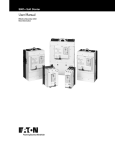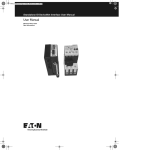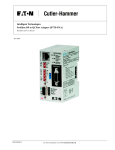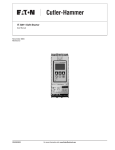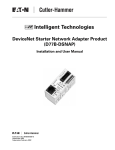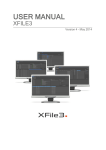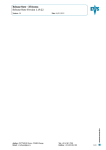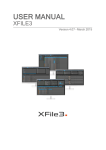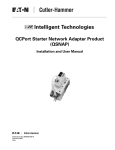Download Eaton Cutler Hammer MN05001002E Setup guide
Transcript
MN03902004E.fm Page 1 Tuesday, November 28, 2006 8:49 AM QCPort Communications QCPort is a protocol developed to provide communications between Eaton’s Cutler-Hammer IT. control products and does not need to be set up for basic local operation of the S811 Soft Starter. The RJ12 connectors (Chan 0, Chan 1) and the 8-position DIP switch located on the front cover relate to the QCPort communication setup. QCPort application and setup information is not covered in this publication. Contact your local Eaton representative or see the QCPort System Install Manual, Pub. No. MN05001002E for more information. DIM Status LED Inspection Main TB Cutler-Hammer Intelligent Technologies (IT.) S811 Soft Starter Installation and Setup Guide Introduction The Cutler-Hammer® Intelligent Technologies (IT.) Soft Starter from Eaton’s electrical business is an electronic self-contained, panel or enclosure mounted motor soft starting device. It provides three-phase induction motors with a smooth start, both mechanically and electrically. The IT. line of soft starters utilizes six SCRs connected in a full wave power bridge. The voltage and current applied to the motor is controlled by varying the SCR conduction period. This, in turn, controls the torque developed by the motor. After the motor reaches speed, a bypass contactor is energized to bypass the SCRs. The IT. Soft Starter is designed to fulfill the industrial service requirements of applications such as chiller starters, pump panels and machine tools. The IT. Soft Starter meets all relevant specifications set forth by ICS-1, ICS-2, ICS-5, UL 508, IEC 60947-4-2, CSA C22.2 No. 14 and CE. This leaflet covers basic installation and setup. A copy of the IT. S811 Soft Starter User Manual (Pub. No. MN03902002E) is downloadable at www.EatonElectrical.com or contact Eaton. No publication can take into account every possible situation. If you require further assistance with any aspect of this product or a particular application, feel free to contact us. MN03902004E General Upon receipt of the unit, verify that the catalog number and unit options stated on the shipping container match those stated on the order/purchase form. Inspect the equipment upon delivery. Report any carton damage to the carrier prior to accepting the delivery. Have this information noted on the freight bill. Eaton is not responsible for damage incurred in shipping. Unpacking Remove all packing material from the unit. Be sure to remove all packing material from lug location. Also, make sure no packing material is left behind that would block the airflow to the fan. Check the unit for any signs of shipping damage. If damage to the product is found after unpacking, report it to the freight company. Retain the packing materials for the carrier to review. Verify that the unit’s catalog number and options match those stated on the order/purchase form. Storage It is recommended that the unit be stored in its original shipping box/crate until it is to be installed. The unit should be stored in a location where: • • • • The ambient temperature is between -58°F and 158°F (-50°C and 70°C) The relative humidity is between 0% and 95%, non-condensing The environment is dry, clean, and non-corrosive The unit will not be subjected to high shock or vibration conditions www.EatonElectrical.com November 2006 MN03902004E.fm Page 2 Tuesday, November 28, 2006 8:49 AM 1.97 (50.0) 2.66 (67.6) 6.47 (164.4) 15.16 (385.0) Slots 5.35 (135.9) 7.38 (187.4) 6.87 (174.5) 3.46 (88.0) .22 (5.5) Typ. 4 Places 16.57 (420.8) 15.63 (397.0) Figure 1: Model S811N (65 mm) 3.54 (90.0) 11.05 (280.6) .26 (6.5) Dia. Typ. 4 Places Figure 5: Model S811V (290 mm) 1.83 (46.4) 1.77 (45.0) 5.53 (140.5) 7.44 (189.0) .27 (6.7) Dia. Typ. 4 Places 3.74 (95.0) 4.38 (111.3) 6.66 (169.2) 7.35 (186.6) 9.84 (250.0) .91 (23.2) .29 (7.5) .89 (22.5) 3.49 (88.5) 2.91 (74.0) .27 (6.8) Typ. 4 Places 2.68 (68.0) 7.92 (201.2) .31 (8.0) Figure 2: Model S811R (110 mm) Frame Size in In. (mm) S811N 7.67 (194.8) 12.71 (322.9) 11.77 (299.0) Slots 5.40 (137.2) 2.95 (75.0) Slots 5.91 (150.0) Slots .28 (7.1) Slots Typ. 6 Places Washer Size Qty. Req. Torque Req. #10 – 32 x 0.5 Standard #10 Lockwasher & Flat Washer 4 15 lb-in (1.7 Nm) 5.8 (2.6) 1/4 – 20 x 0.625 Standard 1/4 in. Lockwasher & Flat Washer 4 25 lb-in (2.8 Nm) 10.5 (4.8) 1/4 – 20 x 0.625 Standard 1/4 in. Lockwasher & Flat Washer 6 30 lb-in (3.4 Nm) 48 (21.8) Quantity: 4 ID: 0.270 OD: 0.495 — 0.505 Max. 0.055 Thick Quantity: 4 Special Washer Included with V Frame Units 8 50 lb-in (5.6 Nm) 103 (46.8) S811R 4.33 (110) S811T, S811U 7.87 (200) .47 (11.9) S811V 11.42 (290) 5.20 (132.0) C Mounting L Mounting Slots for M6 (1/4) Screws (Up to 6 Quantity) 5.20 (132.0) Pole Centers C L 1/4 – 20 x 1.5 Grade 8 Allen head hex cap screws Weight with lugs. Weight without lugs is 41 (18.6). Weight with lugs. Weight without lugs is 91 (41.4). Table 2: Environmental Requirements 7.08 (179.9) 12.72 (323.1) Weight of Unit in lb. (kg) Screw Size 2.55 (65) Figure 3: Model S811T (200 mm) 11.77 (299.0) Mounting .41 (10.5) .49 (12.5) Figure 6: DIM Approximate Dimensions in Inches (mm) Table 1: Mounting Hardware and Torque Specifications 6.39 (162.4) 7.73 (196.3) Figure 4: Model S811U (200 mm) MN03902004E 3.08 (78.3) 2 Operating Temperature Range -40°F to 122°F (-40°C to 50°C) DIM LCD -4°F to 158°F (-20°C to 70°C) Storage Temperature Range -58°F to 158°F (-50°C to 70°C) DIM LCD -22°F to 176°F (-30°C to 80°C) Elevation Above 2000 meters consult factory Humidity Functional to 95% non-condensing Operating Orientation Any orientation in the vertical plane Pollution Degree IEC 60947-1 3 Shock Resistance 15g in any direction Vibration Resistance 3g in any direction November 2006 MN03902004E.fm Page 3 Tuesday, November 28, 2006 8:49 AM Mounting Instructions Power Wiring The IT. Soft Starter is easy to mount. It does not require any special tools. Using the wiring diagrams in Figures 7 – 10 and Table 3 below as guides, connect the Line, Motor, and Power Supply wiring in accordance with appropriate local and national codes. For more detailed information and special applications refer to the IT. S811 Soft Starter User Manual (Pub. No. MN03902002E). To aid you with panel layout, refer to the dimension drawings shown in Figures 1 through 5. Drill and tap holes per mounting hole/slot locations as shown. To mount the unit, use all the hardware specified in Table 1 of this leaflet. Tighten to the torque specified. Note: To provide optimum motor protection the Line and Motor power wiring should be tightly bundled and run perpendicular to the orientation of the S811. Danger High Voltage Hazardous voltage can cause electric shock and burns. To avoid shock hazard, disconnect all power to the controller, motor or other control devices before any work is performed on this equipment. Failure to do so will result in personal injury, death or substantial property damage. Do not apply a disconnect device on the output of the IT. Soft Starter unless a means to turn off the soft starter when disconnect switch is open is utilized. Opening disconnect while the IT. Soft Starter is operating may cause a malfunction. Closing disconnect switch while the IT. Soft Starter is operating will result in a soft starter failure and potential equipment damage and personnel hazard. 1 L1 3 L2 5 L3 S811 Danger Haute Tension Une tension électrique dangereuse peut causer des chocs électriques et des brûlures. Pour éviter des chocs électriques, débrancher l’alimentation du contrôleur, du moteur ou des autres appareils de contrôle avant d’y effectuer du travail. L’inobservation de ces instructions entraînera des blessures corporelles graves, la mort ou des dégâts matériels substantiels. Ne pas appliquer un appareil de sectionnement sur la sortie du démarreur progressif IT. à moins qu’un moyen d’éteindre le démarreur progressif quand l’interrupteur de sectionnement est ouvert soit utilisé. Le fait d’ouvrir l’interrupteur de sectionnement pendant le fonctionnement du démarreur progressif IT. peut entraîner une défaillance. Le fait d’éteindre l’interrupteur de sectionnement pendant le fonctionnement du démarreur progressif IT. entraînera la défaillance du démarreur progressif et des dégâts à l’équipement ou risque au personnel. 2 T1 4 T2 6 T3 M 3 ˜ Figure 7: Line Connected Soft Starter Power Wiring Diagram Peligro alto voltaje Supply L1S L2S L3S Voltajes peligrosos que pueden causar descargas eléctricas y quemaduras. Para evitar descargas eléctricas, desconecte la alimentación del controlador, del motor u otros dispositivos de control antes de efectuar cualquier trabajo en el equipo. El incumplimiento de estas medidas ocasionará lesiones personales, la muerte o daños importantes al material. No aplique un dispositivo de desconexión a la salida del arrancador IT. Soft Starter a menos que se utilice un medio para apagar el arrancador cuando el interruptor de desconexión está abierto. La apertura del interruptor de desconexión mientras el arrancador IT. está operando puede ocasionar un funcionamiento incorrecto. El cierre del interruptor de desconexión mientras el arrancador IT. está operando producirá una falla de dicho arrancador, como también potenciales daños a los equipos y riesgo para el personal. L3 1 3 5 L1 L2 L3 T5 T2 T5 T4 T6 S811 Motor L2 L2 T4 2 4 6 T1 T2 T3 L3 T2 T3 T3 T1 T6 T1 T3 T2 T1 L1 L1 Figure 8: Inside-the-Delta Connected Soft Starter Power Wiring Diagram for a 6-Lead Motor MN03902004E 3 November 2006 MN03902004E.fm Page 4 Tuesday, November 28, 2006 8:49 AM Table 3: Power Wire Sizing and Torque Requirements 12-Lead Low Voltage Supply L1S L2S L3S L3 L3 T11 T10 T12 T5 T4 T6 1 3 5 L1 L2 L3 Motor S811 2 4 6 T1 T2 T3 T3 T2 T1 T9 T8 T7 Number of Conductors T11 T8 T5 T2 L2 T2 L2 T4 T10 T1 T7 L1 Lug Type Wire Sizes Cu 75°C Only Torque Requirements 2 AWG 50 lb-in (5.6 Nm) Frame Size — N 1 Box Lug T3 T3 T9 T6 T12 4 – 6 AWG 45 lb-in (5.0 Nm) 8 AWG 40 lb-in (4.5 Nm) 10 –14 AWG 35 lb-in (4.0 Nm) 14 – 8 AWG (2.5 – 10 mm2) 90 – 100 lb-in (10.1 – 11.3 Nm) Frame Size — R 1 Box Lug T1 L1 6 – 4 AWG (16 – 25 mm2) 3 – 3/0 AWG (27 – 95 mm2) Figure 9: Inside-the-Delta Connected Soft Starter Power Wiring Diagram for a 12-Lead Low Voltage Motor Frame Size — T (see Note) 12-Lead High Voltage Supply L1S L2S L3S L3 T11 T10 T12 1 3 5 L1 L2 L3 S811 2 4 6 T1 T2 T3 Motor T8 T7 T6 T5 T4 T9 L2 T3 T2 T1 L1 L2 T11 T8 T5 T2 T2 T10 T7 T4 T1 T1 L3 T3 T3 T6 T9 2 (2) EML22 4 – 1/0 MCM (21.2 – 53.5 mm2) 250 Lb-in (28.3 N•m) 1 (2) EML23 4/0 – 500 MCM (107 – 240 mm2) 250 Lb-in (28.3 N•m) 2 (2) EML24 4/0 – 500 MCM (107 – 240 mm2) 250 Lb-in (28.3 N•m) 1 (2) EML25 2/0 – 300 MCM (70 – 150 mm2) 225 Lb-in (25.5 N•m) 2 (2) EML26 2/0 – 300 MCM (70 – 150 mm2) 225 Lb-in (25.5 N•m) (2) EML24 4/0 – 500 MCM (107 – 240 mm2) 250 Lb-in (28.3 N•m) (2) EML26 2/0 – 300 MCM (70 – 150 mm2) 225 Lb-in (25.5 N•m) Frame Size — U (see Note) T12 2 L1 Frame Size — V (see Note) Figure 10: Inside-the-Delta Connected Soft Starter Power Wiring Diagram for a 12-Lead High Voltage Motor 2 (2) EML28 4/0 – 500 MCM (107 – 240 mm2) 250 Lb-in (28.3 N•m) 4 (2) EML30 4/0 – 500 MCM (107 – 240 mm2) 250 Lb-in (28.3 N•m) 6 (2) EML32 4/0 – 500 MCM (107 – 240 mm2) 250 Lb-in (28.3 N•m) (2) EML33 2/0 (70 – 300 MCM2 – 150 mm ) 225 Lb-in (25.5 N•m) 4 Requires special lug cover. Check with Eaton for availablility. CSA approved 350 MCM – 500 MCM. Note: For T, U and V frames, optional lug kits are shown (EML**) and may be required for your installation. Control Wiring Figures 11, 12 and 13 illustrate typical connection diagrams for the control circuit options described. In these diagrams the soft starter is represented by the removable wiring connector. All other items shown are not included but may be purchased from Eaton. Control wiring is connected to the IT. S811 Soft Starter by a 12-pin terminal block located at the front of the unit. Using the wiring diagrams in Figures 11, 12 and 13 and Tables 4 and 5 as guides, connect the control wiring as required for your application. MN03902004E 4 November 2006 MN03902004E.fm Page 5 Tuesday, November 28, 2006 8:49 AM Power Supply Power Supply 24V DC + 24V DC – + (See Note 1) – + * E-Stop Stop Start Jumper +24V to 3 Jog Reset In Bypass Ready Fault * 24V DC Power P 1 2 3 4 13 14 95 96 98 (See Note 3) – + * E-Stop S811 Soft Starter P 1 2 3 4 13 14 95 96 98 Jumper +24V to P Inputs 24V DC Only Internal Contacts * Optional 24V DC Pilot Lights (See Note 2) E-Stop Maintained – (See Note 1) E-Stop Maintained 24V DC Power S811 Soft Starter Inputs 24V DC Only Internal Contacts Figure 13: Basic Connection Diagram for Use of DIM Control Only Figure 11: Basic Connection Diagram for 24V DC 3-Wire Pushbutton STOP/START/JOG/RESET and 24V DC Fault/Ready and Bypass Indication Note: 1. A minimum of wire of 14 AWG (2.5 mm2) should be used between the power supply and the 24V DC + and terminals. Power Supply 2. See User Manual if it is desired to use a relay instead of an indicating lamp for terminals 13, 14, 95, 96 and 98. 24V DC + – (See Note 1) * E-Stop Jumper +24V to 3 Jumper Hand OFF Auto Remote (See Note 3) Contact Reset In Bypass Ready Fault * E-Stop Maintained – + P 1 2 3 4 13 14 95 96 98 3. The start input TB #1 default is set for level sense – See User Manual. 24V DC Power S811 Soft Starter Caution Inputs 24V DC Only Only apply 24V DC to the terminal block unless specified otherwise in this manual. All control wiring is 22 – 12 AWG (0.33 – 2.5 mm2). Failure to follow this caution could result in severe damage to the controller. Internal Contacts Attention Appliquer seulement 24V CC à la barrette à bornes sauf ce manuel offre d’avis contraire. Tout le câblage de commande est de calibre 0,33 – 2,5 mm 2 (22 – 12 AWG). L’inobservation de cet énoncé pourrait entraîner des dégâts matériels au contrôleur. Optional 24V DC Pilot Lights (See Note 2) Precaución Figure 12: Basic Connection Diagram for 24V DC 2-Wire Switch HAND/OFF/AUTO(Remote Contact)/RESET and 24V DC Fault/Ready and Bypass Indication MN03902004E Aplique sólo 24 V CC al bloque de terminales, a menos que se especifique lo contrario en este manual. Todo el cableado de control es de 0.33 – 2.5 mm 2 (22 – 12 AWG). Si no respeta esta precaución, se pueden producir daños graves al controlador. 5 November 2006 MN03902004E.fm Page 6 Tuesday, November 28, 2006 8:49 AM Table 4: S811 Terminal Block Control Wiring Name Terminal Block Designation (Pin) Factory Default Input Connections Circuit Common - — Negative Power + — 24V DC nominal (see 24V DC Power Supply Requirements section for sizing of power supply) Power supply connections: – Connect power supply negative to pin “–” and to system ground – Connect +24V DC output to pin “+” Note: To avoid voltage drop during bypass contactor inrush, a minimum of 14 AWG wire should be used between the power supply and the “+” and “–” inputs at the S811 terminal block. Permissive P Hardwired STOP 24V DC only (maintained input) Pin “P”, permissive, must be energized (+24V DC) to enable operation of the unit. If power is removed from the permissive circuit at any time, the unit will begin a STOP command. If a soft stop is selected, the soft stop will begin and run to time-out. Input 1 1 START 24V DC only (momentary input) Applying 24V DC to Input 1 while P is energized will initiate a START. As shipped from the factory this input is “level” sensitive. Input 2 2 JOG 24V DC only (momentary input) Input 2 is JOG. Applying 24V DC to this input while P is energized will initiate a JOG. Input 3 3 HAND/AUTO 24V DC only Must be maintained for control from the terminal block Input 3 is HAND. Hand must be energized to enable control (START/JOG) through the terminal block. Input 4 4 Fault RESET 24V DC only Input 4 is Fault RESET. Energizing this input will reset a fault only after the fault condition has been corrected. Relay1 Form A NO Contact 13 Common 14 NO De-energized 3 Amps, @ 230V AC/24V DC, 3 Amps, Max (Resistive) Switching NO Form A contact: As shipped from the factory this programmable contact closes when the starter’s bypass contactor is energized. It will remain closed until a STOP is initiated. The motor may continue to run even after the STOP is initiated until the stop ramp has been completed. Form C Common 95 Common Form C Common for 96 and 98 Relay2 Form C NC Contact 96 NC De-energized 3 Amps, @ 230V AC/24V DC, 3 Amps, Max (Resistive) Switching Form C contacts: As shipped from the factory these programmable contacts will change status when a Fault occurs. Relay2 Form C NO Contact 98 NO De-energized 3 Amps, @ 230V AC/24V DC, 3 Amps, Max (Resistive) Switching Protective Features Table 5: Terminal Block Specifications Wire Size Number of Conductors Torque 22 – 14 AWG 2 (0.33 – 2.5 mm2) 3.5 lb-in (0.4 Nm) 12 AWG (4.0 mm2) 3.5 lb-in (0.4 Nm) 1 Table 7: S811 Protective Features 12 Pin TB for Control Wiring Protective Feature Setting Factory Default (Protections Menu) Parameter Overload 32 – 100% 32% Overld Trip FLA Trip Class 5, 10, 20 and 30 20 Ovrld Trip Class Overload Enable, Disable Enabled Overload Fault Auto Reset Manual, Auto Manual Reset Mode Jam Enable, Disable Enabled Jam Fault Stall Enable, Disable Enabled Stall Fault Phase Loss Enable, Disable Enabled Phase Loss Fault Phase Rev Fault Phase Reversal Enable, Disable Enabled, ABC Phase Imbalance Enable, Disable Enabled Phase Imb Fault Undercurrent 1 – 100% FLA 6% FLA Lo I Trip % FLA Rated Voltage 115 – 690V 480V — 24V DC Power Supply Requirements Undervoltage Enabled, 90% A 24V DC power supply for your S811 Soft Starter must meet the following requirements: Enable, Disable 1 – 99% rated voltage Lo Volt Trip Lo Volt Level Overvoltage Enable, Disable 101 – 120% rated voltage Enabled, 110% Hi Volt Trip Hi Volt Level • • • • Minimum steady state power: 25 watts Minimum bypass contactor inrush: 240 watts for 150 mS Maximum voltage: 30V DC Minimum voltage: 19.2V DC See S811 User Manual (Pub. No. MN03902002E) for a complete list of protective features. Of rated current. Disabled until next power cycle. 80V AC fixed trip. It is recommended that one of the following CutlerHammer power supplies shown in Table 6 be used. Table 6: Power Supply Ratings Catalog Number Steady State Wattage Surge Wattage Input Voltage PSS55A 55W 250W 115V AC PSS55B 55W 250W 230V AC PSS55C 55W 250W 360 – 480V AC MN03902004E 6 November 2006 MN03902004E.fm Page 7 Tuesday, November 28, 2006 8:49 AM Programming the S811 Soft Starter Operating Modes A Digital Interface Module (DIM) is used to program all models of the IT. S811 Soft Starter. The IT. S811 Soft Starter will start a motor and its load in one of two modes, Voltage Ramp or Current Limit. The mode is set by the Start Method parameter. Using the DIM Referring to Figures 14 and 15 — • The Status Bar at the top of the display indicates the operating and communicating status of the S811 and DIM. • The three Soft Key Functions at the bottom of the display indicate the functions of the Soft Keys (pushbuttons) directly below them. The Soft Key Functions will change as you navigate through the different menus of the DIM. • The center of the display shows the value of the selected S811 parameter. The default display at power-up is “3 ø Line Currents”. • Pages 14 – 21 show how the S811’s parameters are organized within the menu structure. Navigating through the menus down to the parameters is straightforward if you understand a few basic concepts. 1. The Escape Key (ESC) moves you from the User Display to the Parameter Edit Screen. 2. The PREV and NEXT soft keys (Figure 15) scroll from menu to menu (left and right). 3. The far right soft key will allow you to take action (Enter, Edit, More, Send, …) to “drill down” into the menu or parameter. 4. When you enter a menu, the Previous and Next soft keys scroll from parameter to parameter (up and down) in that menu. 5. The Escape Key backs you out of the current parameter or menu. For further information on the operation, including access levels of the DIM, refer to the IT. S811 Soft Starter User Manual (Pub. No. MN03902002E) available at the Eaton Electrical Web Site www.EatonElectrical.com. Voltage Ramp Start Starting at an initial value set by the Initial Torque parameter, the voltage applied to the motor is gradually increased at a rate that will reach rated voltage at the time set by the Soft Start Time parameter. As the voltage increases, the motor develops torque that accelerates the load. When the S811 senses that the motor is up to speed, it quickly completes the voltage ramp and closes the bypass contactor. It should be noted that a lightly loaded motor takes less torque, and thus lower voltage and time, to accelerate to full speed. For this case the S811 will go into bypass before the ramp reaches full voltage. In other words, the S811 may go into bypass before the Soft Start Time has elapsed. Bypass Torque Voltage Ramp Kick Start Torq Initial Torque Rated Voltage 100% Soft Start Time Kick Start Time Start Run Time (Seconds) Bypass 100% JOG RESET H->A Status Bar Speed ONLN SS OXFDO1 H STOP 3 Line Currents XXXX L1 Amp XXXX L1 Amp XXXX L1 Amp Soft Key Functions Soft Keys Predefined Keys ESC Start Run Time (Seconds) Figure 14: Digital Interface Module (DIM) — Display Mode Figure 16: Ramp Start ONLN SS OXFDO1 H STOP Current Limit Start During a Current Limit Start the S811 applies a constant voltage to the motor, resulting in limited current flowing through the motor’s windings. This mode is typically used when it is necessary to limit current during start due to line power limitations or other considerations. The level of current is set by the Initial Torque parameter. Status Bar Monitoring PREV NEXT ENTER Soft Key Functions Soft Keys Predefined Keys Note: Current Limit Starts are not recommended on variable torque load applications such as fans and pumps. ESC Figure 15: Digital Interface Module (DIM) — Parameter Edit Mode MN03902004E 7 November 2006 MN03902004E.fm Page 8 Tuesday, November 28, 2006 8:49 AM IMPORTANT: Note the following items before you begin. Bypass Kick Start Torq 1. P and Hand inputs must be energized (24V DC) to enable starting of the soft starter from the terminal block. 2. To Start: Apply 24V DC to Input 1 while the P input is energized. 3. To initiate a Stop, remove the P input. 4. For 2-wire control, jumper P and Input 1 together. 5. After an Overload Trip, the S811 Soft Starter cannot be restarted until the prescribed cool-down time has elapsed. Cycling power does not reset the timer. If 24V DC power is removed, the soft starter will remember the remaining time and will resume the cool-down timing when power is again applied. 6. On Frames R, T, U and V when the S811 goes into bypass, a sound similar to contactor chatter can be heard. This sound is the result of multiple contactors closing one after the other in a very short period. It is normal operation intended to reduce the surge current requirements of your power supply. Current Initial Torque 100% Soft Start Time Kick Start Time Start Run Time (Seconds) Bypass Speed 100% Danger The S811 has the ability to respond to commands from an automated network controller. Consequently the soft starter may start unexpectedly in response to these commands. To insure the safety of personnel and equipment, always remove power before accessing the electrical and/or mechanical equipment. Danger Start Le S811 à la capacité de répondre aux commandes d’un contrôleur de réseau automatisé. Donc le démarreur progressif peut démarrer soudainement en réponse à ces commandes. Pour s’assurer la sécurité du personnel et de l’équipement, toujours débrancher l’alimentation avant d’accéder à l’équipement électrique et/ou mécanique. Run Time (Seconds) Peligro Figure 17: Current Limit Start El S811 tiene la capacidad de responder a comandos de un controlador de red automatizado. Por lo tanto, el arrancador suave podría arrancar de improviso en respuesta a estos comandos. Para garantizar la seguridad del personal y del equipo, siempre desconecte la energía antes de acceder al equipo eléctrico o mecánico. Kick Start — This feature provides an initial boost in torque to overcome the initial static friction in some applications. The level of torque boost is set by the Kick Start Torq parameter and the duration of the “kick” is set by the Kick Start Time. Setting the Kick Start Time to 0 disables this feature. Quick Setup Configuring the S811 Soft Starter After all power and control connections have been made and you have read and understood the different operating modes of the soft starter, it is time to program it for your application. As shipped from the factory, the S811 Soft Starter’s default configuration is sufficient for basic operation but may require some configuration to “tune” it for your application. The following basic setup procedure assumes you understand how to navigate through the S811’s parameter menu using the Digital Interface Module (DIM) and that the S811 is in its Factory (Out-of-Box) state. Refer to the S811 User Manual (Pub. No. MN03902002E), Chapter 8, for a detailed explanation of the DIM. Soft Stop — This feature is used for applications that require a controlled extended stop. It is designed for high frictional loads that tend to stop suddenly when voltage to the motor is removed. Note: This function will not stop the motor any faster than it would normally take to coast to a stop under load. Coast to Stop (Speed) 100% Speed Soft Stop Ramp (Voltage) Soft Stop Time Run Soft Stop Time (Seconds) Figure 18: Soft Stop MN03902004E 8 November 2006 MN03902004E.fm Page 9 Tuesday, November 28, 2006 8:49 AM Advanced Setup Initial Configuration For proper operation of the S811, these settings must be set prior to use: 1. It is suggested that the S811 Soft Starter be configured before applying the line voltage. Apply 24V DC to the (+) and (-) connections of the S811 terminal block. “Eaton Cutler-Hammer” will be displayed by the DIM while the S811 is powering up. When power-up is complete the DIM should display “3 ø Line Currents”. Note: If anything else is displayed, go to Chapter 8 of the S811 User Manual, Troubleshooting, for information on getting the S811 back to a known state. If Stall faults occur or satisfactory operation is not achieved with the quick setup in the previous section, the problem is most likely related to the torque or time settings. The following procedures using the Soft Start Confg menu are suggested as alternatives. Voltage Ramp Start Configuration 1. Initial parameter settings: • Start Method = Voltage Ramp • Initial Torque = 50% • Soft Start Time = 60 sec • Kick Start Torq = 0% (fans and pumps), 75% (high breakaway loads) • Kick Start Time = 0 sec (fans and pumps), 1 sec (high breakaway loads) • Soft Stop Time = 60 sec 2. Start the motor and determine the worst case starting conditions. Adjust Initial Torque for smooth start without hesitation. Rotation should begin within 2 seconds. 3. If Stall Faults occur at the end of the ramp time, increase Initial Torque, Kick Start Torq & Time and/or Soft Start Time to get into bypass before the Soft Start Time elapses. Also, verify that the motor is not overloaded. 4. Adjust the Soft Stop Time for the desired stopping time. 2. Using the DIM, review the parameter settings in the “Soft Start Confg”, “Overload Config” and “Protection Setup” menus. The following setup procedures will use the factory default settings unless changed by you. Note: Refer to the Menu structure shown on Pages 10 – 13 for the location and more information on the parameters referenced in this setup. 3. In the Overload Config menu set the Overld Trip FLA parameter to the motor’s nameplate rated current. This setting assumes the motor has a 1.15 Service Factor. 4. Set Ovrld Trip Class parameter for the desired overload trip characteristic (curve). 5. In the Protection Setup menu set the Motor Rated Volt parameter to the motor’s operating voltage. 6. If auto fault reset is required, set the Reset Mode parameter in the Soft Start Confg menu to Auto (and Start Control to Level (default)). Note: Auto Reset is intended for unattended installations where there is no danger to personnel or other equipment when the motor starts without warning. If Auto Reset is enabled, CAUTION must be exercised to assure that any restart occurs in a safe manner. 7. Apply the Mains voltage and verify that no fault is present. If a fault is indicated, display the Diaignostic menu’s Device Status parameter to determine the source of the fault. Each fault is described in the S811 User Manual, Chapter 8, Troubleshooting. • A Phase Reversal Fault commonly occurs on new installations. It can be remedied by either changing the Phase Sequence parameter from ABC to ACB in the Protection Setup menu or removing Mains power and switching the incoming line connections at L1 and L2 of the S811. Current Limit Start Configuration 1. Initial settings: • Start Method = Current Limit • Initial Torque = 50% • Soft Start Time = 120 sec • Kick Start Torq = 0% • Kick Start Time = 0 sec (disabled) • Soft Stop Time = 60 sec 2. Start the motor and determine the worst case starting conditions. Adjust Initial Torque for smooth start without hesitation. Rotation should begin within 2 seconds and the motor should smoothly accelerate to full speed. 3. If Stall Faults occur, increase Initial Torque and/or Soft Start Time to get into bypass before the Soft Start Time elapses. Also, verify that the motor is not overloaded. 4. After suitable performance has been achieved, determine the starting time to bypass and set Soft Start Time at 1.25 times this time. For example, if it takes 10 seconds to accelerate the motor and go into bypass, set the Soft Start Time for 12.5 seconds. 5. Adjust the Soft Stop Time for the desired stopping time. 8. Using the DIM, Jog the motor just enough to verify that the direction of rotation is correct. If it is not, remove all power to the S811 and the motor and swap two of the motor’s winding connections. 9. The S811 should now function properly for most applications. Adjust other parameters to meet your application needs. If satisfactory results are not obtained, see next section for more detailed setup. MN03902004E 9 November 2006 MN03902004E.fm Page 10 Tuesday, November 28, 2006 8:49 AM Fault Codes Table 8: Troubleshooting Fault Table Fault Code Table 8: Troubleshooting Fault Table, continued Possible Problem Possible Solution Fault Code Possible Problem Possible Solution 1 Firmware Incompatibility or Hardware failure. Call Eaton support. 36 3 Internal Communications Fault – Communications to DSP have been interrupted. Possible electrical noise or hardware failure. Try a 24V DC control voltage power cycle to attempt to clear problem. Verify that the S811 is properly grounded. Call Eaton support if the problem persists. Communications Loss Stop Fault – Communications to a remote network controller was lost while motor was running. Device was disconnected or the connection broken. Reattach network controller, replace connection cable. Call Eaton support if the problem persists. 38 4 Low Control Voltage Fault – The external 24V power supply voltage is dropping below the minimum required to control the motor. Use recommended 24V power supplies with enough current sourcing capability to close contactors. Verify correct wire size used to connect power supply to S811. (See power supply specification for more details.) Verify connections are secure. Temperature Sensor Fault – Temperature sensor or interconnection failure. Call Eaton support. Fault can be disabled, but S811 will not be protected against failures caused by excessive internal temperatures. 39 Internal CPU Fault – Firmware Incompatibility or Hardware failure. Call Eaton support. 42 Under Voltage Fault – Incoming AC line voltage below trip threshold. Device connected to incorrect mains supply voltage. Connect to correct supply voltage. Verify Motor Rated Volt is set to correct value. It may be necessary to reduce this setting for soft mains. 43 Over Voltage Fault – Incoming AC line voltage above trip threshold. Device connected to incorrect mains supply voltage. Connect to correct supply voltage. Verify Motor Rated Volt is set to correct value. It may be necessary to increase this setting for high mains. 44 Motor Voltage Phase Reversal Fault – incoming line phase rotation sequence opposite of device setting. Set Phase Sequence to match incoming sequence. If motor is turning in wrong direction swap two motor connection leads. If mains leads need to be changed, swap incoming leads and set Phase Sequence to match incoming sequence. If an upstream reverser is used, disable Phase Rev Fault. 55 Motor Control Command Device Missing Fault – A motor control command device (DIM, Cover Control, or similar device) was removed. Re-attach motor control command device and reset the fault. If the motor command device is to be permanently removed, purge it from the S811’s motor control command device list (press and hold the recessed RESET button on the front of the S811 for six seconds). The STATUS LED will change to amber when the action has started and any detached motor control device has been removed from the S811’s list. 56 Internal Communications Fault 2 – The motor was stopped because of an internal communications error. Possible electrical noise or hardware failure. Try a 24V DC control voltage power cycle to attempt to clear problem. Verify the S811 is properly grounded. Call Eaton support if the problem persists. 57 Internal Program Memory Fault – one or more internal memory locations have been corrupted. Cycle 24V DC power to the S811. Call Eaton support if fault persists. 58 SCR Not Firing Fault – SCR is not conducting when gated. Incoming phase lost. Special application – undersized or high impedance motor, SCR malfunctioning, circuitry damaged by megger testing. Re-apply lost phase. Review S811 application. Call Eaton support if problem persists. 59 Shorted SCR fault – SCR is shorted Call Eaton support if problem from over current abuse, bypass persists. contactor welded shut, application/ configuration issues. 60 SCR Over Current Fault – Excessive SCR Current prior to bypass. Only active when Stall Fault is disabled. Motor should be up to speed prior to bypass. Increase Soft Start Time and/or Initial Torque. Reduce starting load. Verify S811 is properly sized. 61 Mains AC Voltage Loss Fault – fuses blown, disconnect open, or breaker tripped. Replace fuses, close disconnect, or reset breaker. 63 Motor Stall Fault – S811 could not engage the bypass contactors at the end of the motor start time because the start current was too high. Motor did not reach full speed during the start time. Lengthen Soft Start Time and/or increase Initial Torque. Loads that are heavily loaded during a start such as fans will often need an initial torque setting much greater than the factory default. 64 Voltage Zero Cross Lost Fault – Mains lost, phase L1 or L3 lost. Restore mains or lost phases. Call Eaton support if problem persists. 5 Power Pole Over Temperature Fault – The S811 has detected the internal SCR temperature is excessive. Operating environment above specified maximum temperature, ventilation holes blocked, fans are not operational, starts per hour exceed specifications, sensor failure on circuit board, bypass contactor(s) failed to close. Ventilate to specified maximum temperatures, clear obstructions, verify fans are operational, verify control system is not exceeding the specified maximum starts per hour. 6 Phase Loss Fault – Extreme phase imbalance condition. Incoming phase disconnected, blown fuse. Repair broken connection, replace fuse. 7 Phase Imbalance Fault – The imbalance of the incoming phases exceeds the trip threshold. Correct imbalance problem with mains. Increase the xx Imbalance Fault xx parameters or disable the fault if the other issues cannot be resolved. Make sure your system can tolerate the imbalance. 9 Under Load Fault – Current supplied to the motor is below trip threshold. Linkage or belt driven by motor is broken, a clutch or other load engagement device is not operating, the motor is not loaded to the trip current. Repair/replace broken belts, linkage, or clutch, and/or increase load. Reduce Low I Trip % FLA to an acceptable value (0% will disable). 10 Over Current Fault – only active in bypass if the Jam Fault is disabled. Current exceeds the fault threshold. Disconnect power from S811 and any other equipment. Remove obstruction in motor drive train. Verify S811 is properly sized for the application. Jam Fault – While in bypass an obstruction has slowed or stalled the motor resulting in extreme motor current. Disconnect power from S811 and any other equipment and remove obstruction. Jam Fault can be disabled if trips occur during normal operation. Over Current Fault will provide protection at a higher current threshold. 13 Bypass Failure Fault – S811 detected that the internal bypass contact(s) did not close. Possibly opened due to excessive shock or 24V DC control voltage sag (insufficient voltage to maintain contact closure). Verify control power and wire size meets specifications. Reduce shock or vibration. Call Eaton support if the problem persists. 14 Overload Fault – Motor has been overloaded for an extended period of time. Reduce the motor’s load. Verify the Overld Trip FLA and/or Ovrld Trip Class if the overloads are infrequent and are set to match the motor and system. Note: Exceeding nameplate ratings will shorten equipment life. If fault happens during motor start: verify the control system is not exceeding the specified maximum starts per hour. Increase the initial torque to bring the motor up to speed faster. 11 18 Instantaneous Over Current Fault – Starting current excessive. Load too great. Reduce starting load, increase soft starter capacity (be sure model ratings can handle current demands). Call Eaton support for application assistance. 32 Internal NV Memory Fault – Internal memory error. Call Eaton support. MN03902004E 10 November 2006 MN03902004E.fm Page 11 Tuesday, November 28, 2006 8:49 AM ONLN SS OXFDO1 H STOP 3 Line Currents XXXX L1 Amp XXXX L1 Amp XXXX L1 Amp JOG RESET H->A ESC ESC ONLN SS OXFDO1 H STOP ONLN SS OXFDO1 H STOP Monitoring Diagnostics PREV NEXT ENTER PREV ESC ENTER ESC Parameter PREV NEXT MN03902004E ENTER ESC ENTER Monitoring NEXT ESC Menu 1 Units Diagnostics Access Level Parameter Menu 2 Units Access Level 1 3Ø Line Currents Amps 0 1 Device Status 0 2 3Ø Pole Voltages Volts 0 2 Fault/Warn List 0 3 Thermal Memory % 0 3 Fault/Warn Queue 0 4 Current as % FLA % 0 4 Motor Fault Bits 3 5 Pole Temp °C °C 0 5 Motor Status 0 6 DC Cntrl Voltage Volts 0 6 Motor Control 3 7 Device Temp °C °C 0 7 Breaker Status 3 8 Start Count Starts 0 9 3Ø Pole Currents Amps 0 10 Ave Pole Current Amps 0 11 Ave Line Current Amps 0 11 November 2006 MN03902004E.fm Page 12 Tuesday, November 28, 2006 8:49 AM Continues on Page 12 NEXT PREV THEN OR ESC ONLN SS OXFDO1 H STOP ONLN SS OXFDO1 H STOP Soft Start Confg Overload Config PREV NEXT ENTER PREV ESC NEXT ESC ENTER ENTER ESC Soft Start Confg Parameter ESC Menu 3 Units Overload Config Min Max Default Access Level Units Amps Start Method 0 3 0 2 1 Overld Trip FLA 2 Soft Start Time Sec 0.5 180 20 1 2 Ovrld Trip Class 3 Initial Torque % 0 100 45 1 3 Overload Fault 4 Pump Stop Time Sec 5 120 10 1 4 Ovld On Start 5 Soft Stop Time Sec 0 60 0 1 6 Kick Start Time Sec 0 2 0 1 7 Kick Start Torq % 0 100 0 1 8 Start Control 0 1 1 2 9 Reset Mode 0 1 0 2 10 Relay1 Config 0 5 2 2 11 Relay2 Config 0 5 0 2 12 Menu 4 Parameter 1 MN03902004E ENTER Sec Min Max Default Access Level 12 1000 21 2 5 30 20 2 0 1 1 2 0 1 1 2 November 2006 MN03902004E.fm Page 13 Tuesday, November 28, 2006 8:49 AM ONLN SS OXFDO1 H STOP Protection Setup PREV NEXT ENTER ESC ENTER ESC Protection Setup Parameter Menu 5 Units Protection Setup (Continued) Min Max Default Access Level Parameter Menu 5 Units Min Max Default Access Level 1 Phase Sequence 0 1 0 2 13 Phase Loss % Trp % 1 100 80 2 2 Phase Rev Fault 0 1 0 2 14 Phase Loss Trip Dly Sec 1 60 0.5 2 3 Motor Rated Volt 115 600 480 2 15 Low I Trip % FLA % 4 Low Volt Trip 0 1 1 2 16 Phase Imb Fault 5 Low Volt Level % 1 99 90 2 17 I Imbal Trip Lev % 1 100 40 2 6 Low Volt Trip Dly Sec 1 60 3 2 18 I Imbal Trip Dly Sec 1 60 0.5 2 7 Hi Volt Trip 0 1 1 2 19 SCR Short Fault 0 1 1 2 8 Hi Volt Level % 101 120 110 2 20 SCR Conduct Fault 0 1 1 2 9 Hi Volt Trip Dly Sec 1 60 3 2 21 Jam Fault 0 1 1 2 10 V Imbal Trip Lev % 1 100 6 2 22 Stall Fault 0 1 1 2 11 V Imbal Trip Dly Sec 1 60 0.5 2 23 Temp Sense Fault 0 1 1 2 12 Phase Loss Fault 0 1 1 2 Volts 0 100 6 2 0 1 1 2 (Continued at right) MN03902004E 13 November 2006 MN03902004E.fm Page 14 Tuesday, November 28, 2006 8:49 AM ONLN SS OXFDO1 H STOP ONLN SS OXFDO1 H STOP Network Setup Network Status PREV NEXT ENTER PREV ESC ENTER ESC Parameter ESC Menu 6 Units ENTER ESC ENTER Network Setup NEXT Network Status Parameter Menu 7 Min Max Default Access Level Access Level 1 1 Firmware Version 0 0 7 0 3 2 Hardware Version 0 2000 3 3 QCP Fault Status 3 2000 3 4 Node ID 3 3 1 Language Select 2 Comm Loss Action 3 Mot Ctrl Timeout mSec 4 Trans MC Timeout mSec 5 Term Resistor 0 1 3 5 Device ID Tag 6 Baud Rate 0 6 3 6 Slave Address 3 7 Device Mode 0 4 3 7 Production Dest 3 8 Production Intvl mSec 3 8 Device Identity 3 9 Consumpt Intvl mSec 3 9 Config CRC 0 10 Production List 3 10 Parameter List 3 11 Consumption List 3 11 Language List 3 1 Note: A 0 setting will disable this feature until the next factory reset. MN03902004E 14 November 2006 MN03902004E.fm Page 15 Tuesday, November 28, 2006 8:49 AM ONLN SS OXFDO1 H STOP LCD DIM Setup PREV NEXT ENTER ESC ENTER ESC LCD DIM Setup Menu Parameter LCD DIM Setup Menu (Continued) Units Min Max Default Access Level Parameter Units Secs Min Max Default Access Level 0.3 3 PREV 1 Access Level 2 Password 0 26 Run Delay 0 27 Transient Source 3 Access Timeout 4 User Var 1 600 3 28 Refresh Rate 100 3 29 Firmware Version 5 User Var 1 Scale 1 3 30 Term Resistor 6 7 User Var 1 Desc 3 31 Inactive Timeout Secs 0 User Var 1 Units 3 32 Fault Disp Time Secs 0 8 User Var 2 0 3 33 Production Data 1 3 34 Consumption Data 3 3 35 Status 3 0 9 User Var 2 Scale 10 User Var 2 Desc 11 User Var 2 Units 12 Backlight Level 13 Backlight Time 14 Screen Contrast 15 Scan For Devices 16 17 2 Secs 0 600 Disabled 3 mSec 250 3 0 Enabled 1 65535 0 2 30 0 2 3 3 36 App Status 3 0 37 Motor Control 2 0 0 38 Motor Status 2 15 0 39 Device Temp °C 0 2 40 Device Identity 2 Identify Node 0 41 Config CRC 2 Start Discovery 2 42 Node ID 0 18 Reset-Soft 2 43 Device Mode 3 19 Reset-Factory 3 44 Baud Rate 3 20 Reset-App Cfg 2 45 Production Dest 21 Reset-App Fault 2 46 Device ID Tag 22 Reset-Commission 2 47 Production Intvl mSec 100 23 Clear Fault Que 0 48 Consumpt Intvl mSec 2000 3 24 Get Register 2 49 Language List 0 0 25 Set Register Language Select 0 0 Secs 0 300 3 50 (Continued at right) MN03902004E 15 NEXT 2 LCD DIM 0 3 Note: Do not set less than 10 seconds. Except: 0 setting disables timeout. November 2006 MN03902004E.fm Page 16 Tuesday, November 28, 2006 8:49 AM For additional information on this product, please call our Customer-Support Center at: 1-800-356-1243 For service or start-up assistance, 24 hours/day, 7 days/week please call 1-800-498-2678 Eaton Electrical Inc. 1000 Cherrington Parkway Moon Township, PA 15108-4312 USA tel: 1-800-525-2000 www.EatonElectrical.com © 2006 Eaton Corporation All Rights Reserved Printed in USA Publication No. MN03902004E/CPG November 2006

















